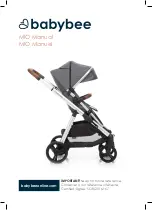
Scheduling & Operation Modes
29
VAV/Zone Controller Package
SEQUENCE OF OPERATIONS
HVAC Modes of Operation
There are 7 possible modes of operation for the HVAC Unit and
the VAV/Zone Controller. These modes are determined by the
Supply Air Temperature (SAT) and/or space demand conditions.
They are:
•
Supply Air Vent Mode
(Based on HVAC Unit SAT)
This mode occurs when the Supply Air Temperature
is within 2°F of the Space Temperature and stays in
this mode until the Supply Air Temperature is above
or below the Space Temperature plus or minus the
Supply Air HVAC Mode Deadband.
Space Vent Mode
(Based on VAV/Zone Controller Space Temp)
This mode occurs when the Space Temperature is
below the Cooling Setpoint and 1.0°F above the
Heating Setpoint.
Scheduling
Occupied/ Unoccupied Mode
The VAV/Zone Controller monitors the communications loop for
its Occupied and Unoccupied mode of operation command. Either
the Unit Controller or a GPC-XP Controller can transmit the Oc-
cupied command to the VAV/Zone Controller. This requires the
VAV/Zone Controller Packages to all be connected to the system
communication loop through their RS-485 connector and to be
properly addressed for the command to be received.
Push-button Override Operation
During unoccupied hours, you can force the VAV/Zone Controller
and Unit Controller back to occupied operation by pressing the
override button on the Modular Room Sensor or Digital Room
Sensor. The operation for the push-button override sequence is
diff erent depending on which sensor you are using.
Standard Room Sensor
Pushing the override button for less than 3 seconds initiates the
override which will continue for a confi gurable duration of time
(0-8 hours). If during the override period the button is pressed a
second time for less than 3 seconds, an additional confi gurable du-
ration of time (0-8 hours) will be added to the remaining override
duration that is left at the time of pushing the button. Depressing
the button between 3 and 10 seconds will cancel the override.
Digital Room Sensor
Pushing the override button momentarily initiates the override
which will continue for a confi gurable duration of time (0-8
hours). If during the override period the button is pressed a second
time, it will cancel
Damper Positions
The actual values for the minimum damper positions that are
described in the following paragraphs can be confi gured by
changing the values in the setpoint screens for the VAV/Zone
Controller. These minimums are expressed in damper open
percentages for pressure dependent terminal units or in CFM for
pressure independent terminal units.
Cooling Minimum
When the HVAC unit is in the Supply Air Cooling Mode but the
space does not require cooling, the VAV/Zone damper will move
to the Cooling Minimum position.
Heating Minimum
When the HVAC unit is in the Supply Air Heating Mode but the
space does not require Heating, the VAV/Zone damper will move
to the Heating Minimum position.
Vent Minimum
This is the position the VAV/Zone damper will move to when the
HVAC unit is in the Supply Air Vent Mode.
Supply Air Cooling Mode
(Based on HVAC Unit SAT)
This mode occurs when the Supply Air Temperature
falls to less than the Space Temperature minus the
Supply Air HVAC Deadband. To cancel the Supply
Air Cooling Mode, the Supply Air Temperature must
rise to within 2°F of the Space Temperature.
Space Cooling Mode
(Based on VAV/Zone Controller Space Temp)
This mode occurs when the Space Temperature rises
above the Space Cooling Setpoint.
Supply Air Heating Mode
(Based on HVAC Unit SAT)
This mode occurs when the Supply Air Temperature
rises to a temperature that is greater than the Space
Temperature plus the Supply Air HVAC Deadband.
To cancel the Supply Air Heating Mode, the Supply
Air Temperature must fall to within 2°F of the Space
Temperature.
Space Heating Mode
(Based on VAV/Zone Controller Space Temp)
This mode occurs when the Space Temperature falls
below the Space Heating Setpoint.
Off Mode
- (Not displayed)
During Unoccupied Mode, the mode is considered
OFF if the Space Temperature does not generate a
Heating Mode or Cooling Mode based on the
Unoccupied Heating & Cooling Setpoints.















































